The Open Group ArchiMate 3 Part 2 OGA-032 Exam Practice Test
Please read this scenario prior to answering the question
ArchiSurance has decided to leverage its financial expertise by offering defined contribution retirement plans. Each trading day, ArchiSurance submits consolidated mutual fund trading transactions to a stock exchange on behalf of its retirement plan
participants.
The daily mutual fund trading cycle consists of four key processes: Transaction capture, pricing, trading and reconciliation. Transaction capture consists of two sub-processes: manual exchange and loans and distributions (L&D). For transaction
capture, retirement plan participants use an online account management application to enter manual fund exchange transactions. For L&D, plan participants use a separate application to enter requests. The L&D application determines whether the
request can be fulfilled based on the mutual fund balances held in each plan balances and a set of business rules. Each day's captured manual exchange transactions accumulate in a transaction database.
ArchiSurance contracts with a third-party information service to receive a file of mutual fund prices at the close of each trading day. The pricing application uses this file to convert captured transaction into trades, and then validates each trade against the
mutual fund balances held in each plan. The pricing application generates a trade file with the minimum number of trades necessary. The trading application sends this file to an external trading service. When the trading application receives a
confirmation file back from the trading service, it passes it to the reconciliation application, which updates the plan recordkeeping database.
The lead application Architect has decided to merge the pricing application, the trading application and the reconciliation application into one application, which will be serving the pricing, trading and reconciliation processes respectively. The reason for
this is that maintenance costs for these three components are too high and the performance is too slow. This implementation will increase the performance and lower the maintenance cost significantly.
The CIO has agreed on this plan, but wants this to be done in two phases, each in a separate project. Phase 1 should include the merger of the Trading and Pricing applications. Phase 2 should then merge the merged applications with the Reconciliation
application respectively. Each project phase has a number of defined deliverables. Phase 1 has two deliverables, TraPri application implemented and tested' and 'Active TraPri application', which together form a first transition architecture. Phase 2 has
two deliverables, 'Recon 2.0 application implemented and tested' and 'Back-up applications phased out', which together form the second transition architecture. These two projects are part of the ArchiSurance application integration program scheduled
for the next 6 months.
Refer to the Scenario
You have been asked by the lead application architect to show how the applications used for daily trading can be migrated. This should include a description of the work packages, deliverables and transition architectures.
Which of the following answers best describes the applications and migration plan?
A.
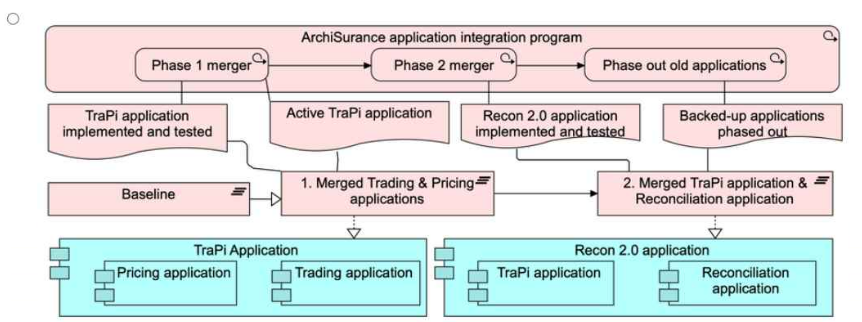
B.
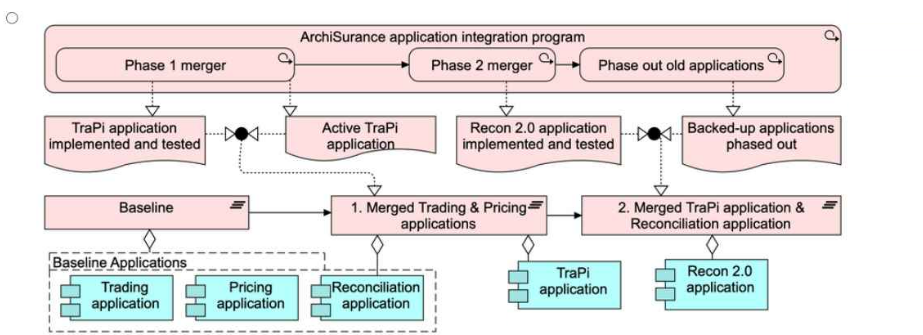
C.
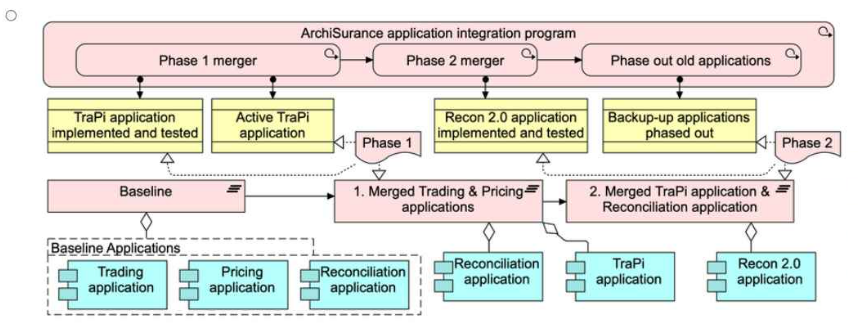
D.
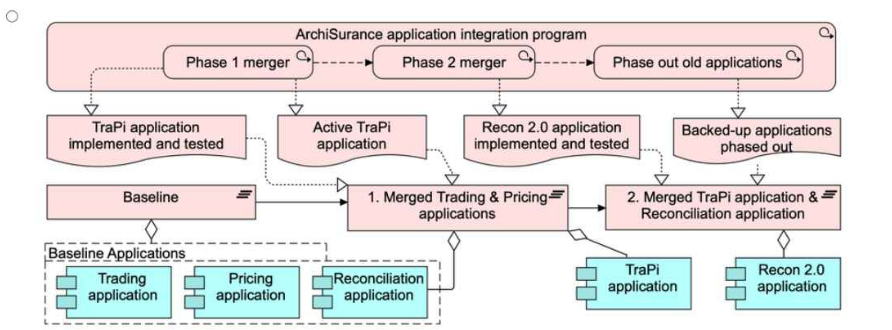
Answer : D
We need to determine the best model that:
Shows the current applications and their functions -- Pricing, Trading, and Reconciliation applications.
Represents the migration phases --
Phase 1: Merges the Trading and Pricing applications into TraPri.
Phase 2: Merges TraPri with the Reconciliation application to create Recon 2.0.
Includes transition architectures -- Each phase has distinct deliverables marking the transition from old applications to new merged applications.
Shows the work packages and dependencies -- The sequence of activities leading to the final implementation.
Why D is the Best Choice:
Clearly distinguishes baseline (existing) applications and the new applications after the migration. Illustrates the two transition states correctly --
First transition: Implementation and activation of the TraPri application.
Second transition: Implementation of Recon 2.0 and phase-out of backup applications. Depicts the migration process sequentially -- Ensuring a clear understanding of how the applications evolve over time. Work packages and deliverables are well structured -- Aligning with the phases described in the scenario.
Why Not A, B, or C?
A: Does not correctly represent the transition phases and their deliverables.
B: Lacks clarity in differentiating baseline applications from transition architectures.
C: Misrepresents dependencies and transition states, making the migration process unclear.
Please read this scenario prior to answering the question
The ArchiSurance enterprise document management solution includes a sophisticated ecosystem of applications and technologies. Designed with a strong emphasis on high availability, it plays a vital role in providing support for a diverse range of
document types and managing a substantial volume of document-based transactions on a daily basis. Recognizing its importance to the business, the document management solution is redundantly hosted at two geographically separate data
center sites, both configured identically for seamless operations.
The system software at the core of the document management solution is comprised of three key modules. The Document Engine serves as a repository, facilitating document storage, retrieval, and various other operations. The Workflow Engine
acts as a host for document management applications, while the Application Engine powers the most advanced and sophisticated applications within the system.
Two key factors have driven the Architecture Board's approval of a project aimed at updating this critical solution. Firstly, the supplier of the Workflow Engine has given notice of the end of support for the current software version, necessitating an
upgrade. Secondly, the system administrator responsible for the Application Engine has flagged the need for hardware replacement on the server where the software is currently running. Given that the Claim Management application shares
infrastructure with the Application Engine, the involvement of the system administrator responsible for this application is crucial in the project planning and execution.
Refer to the Scenario
You are the Enterprise Architect within this organization. You have been assigned the task of modeling the applications and technology for this solution, as well as outlining the motivations driving the need for its update.
Based on the scenario, which answer provides the most complete and accurate description?
A.
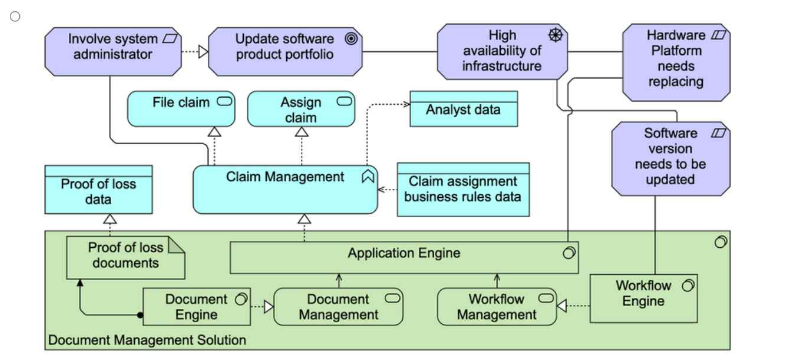
B.
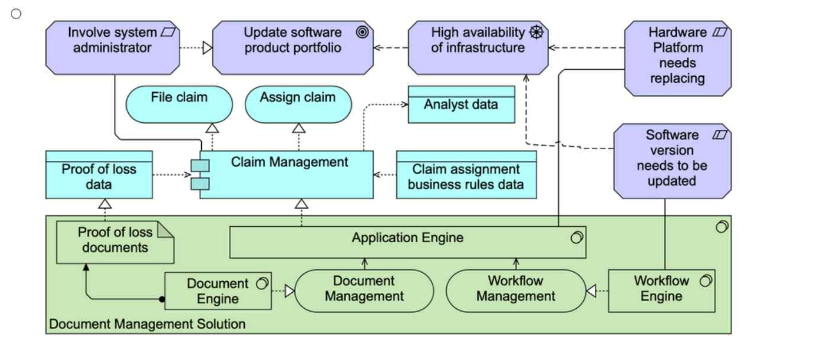
C.
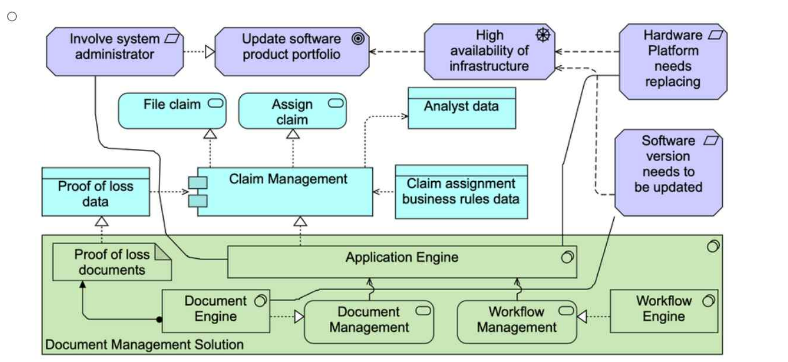
D.
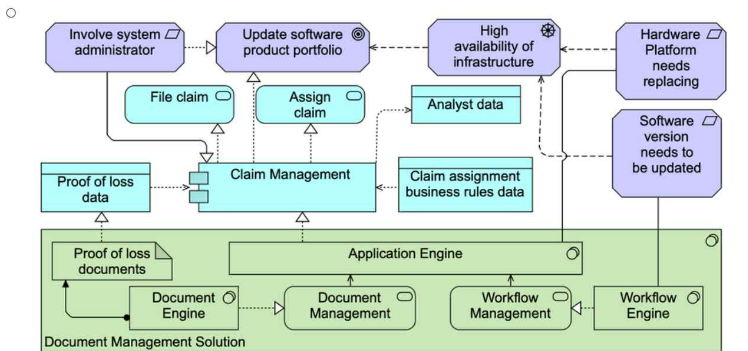
Answer : D
This scenario revolves around ArchiSurance's document management solution and the motivations behind updating the solution due to software and hardware challenges. The task is to model both the applications and technology components involved, along with the motivations driving the need for an update.
Key ArchiMate 3.2 Concepts Applied:
Applications and Components:
Claim Management Application: This application handles key processes such as filing claims and assigning claims, and it shares infrastructure with the Application Engine.
Document Management Solution: Includes several subsystems such as:
Document Engine: Manages document storage, retrieval, and processing operations.
Workflow Engine: Facilitates document workflows and supports document-related operations.
Application Engine: Hosts sophisticated applications like Claim Management.
Data Objects:
Proof of Loss Documents and Proof of Loss Data are critical components managed by the Document Management Solution. This data is processed and handled by both the Document Engine and the Claim Management application.
Technology and Infrastructure:
Hardware Platform Needs Replacing: The Application Engine runs on hardware that needs replacement. This drives a part of the motivation for updating the infrastructure.
Software Version Needs to Be Updated: The Workflow Engine is running on outdated software, necessitating an upgrade to ensure continued support and functionality.
High Availability of Infrastructure: Given that the system is redundantly hosted across two data centers, high availability is crucial for seamless operations. This includes continuous availability for the document management processes.
Motivations and Drivers:
The end-of-support notice from the Workflow Engine supplier requires an upgrade to maintain operational continuity.
The system administrator responsible for the Application Engine has raised concerns about hardware needing replacement, adding urgency to the infrastructure upgrade.
Why Option D is Correct:
Option D provides the most comprehensive representation of the applications, infrastructure, and motivations for updating the solution.
It clearly shows the Claim Management Application and its interaction with the Claim Assignment Business Rules Data, as well as how it relies on the Application Engine.
The Document Management Solution and its subsystems (Document Engine, Workflow Engine, and Application Engine) are correctly depicted, with clear relationships to the data they manage (Proof of Loss Documents and Data).
The motivations for change---specifically, the need to update the Workflow Engine software and replace the hardware platform---are clearly shown, alongside their impact on the overall system.
The diagram shows the involvement of the system administrator in the update process, which is important for ensuring smooth project execution.
Why Other Options Are Incorrect:
Option A and Option B do not accurately capture all necessary relationships, particularly the connections between the Claim Management application and its reliance on the Application Engine infrastructure. They also miss some of the drivers related to the required hardware replacement.
Option C omits some key details regarding how the Claim Management Application and Document Management Solution components interact with the system, particularly the Claim Assignment Business Rules Data and Proof of Loss Data.
Conclusion:
Option D is the best answer because it offers the most complete and accurate representation of the applications, technology infrastructure, and drivers for the update project. It clearly illustrates how the Claim Management and Document Management systems work together, along with the necessary infrastructure updates, in line with ArchiMate 3.2 modeling standards.
Please read this scenario prior to answering the question
ArchiCar is a specialized company that focuses on manufacturing luxury electric cars and powertrain components, along with producing battery-charging equipment. With its own distribution network and showrooms, ArchiCar adopts a direct-to-
customer sales model through online channels.
The manufacturing of ArchiCar's electric cars is carried out on fully automated assembly lines. Leveraging a cutting-edge manufacturing process, the company boasts an impressive ability to sell and deliver a vehicle within just one month from the
time of order placement. Anticipating significant growth, the CEO has set ambitious plans to increase annual production from 100,000 to 500,000 vehicles within a three-year timeframe.
To ensure the highest quality standards, ArchiCar relies on locally manufactured finished steel from the renowned ArchiMetal plant. ArchiMetal specializes in lightweight steels that allow ArchiCar to achieve a reduced vehicle weight without
compromising strength and crash performance. The finished steel is efficiently transported by rail to ArchiCar's production plant, where it is stored in a dedicated warehouse until required for the automated car assembly process. Conveyor belts
facilitate the seamless transfer of the finished steel from the warehouse to the assembly plant.
At the ArchiCar assembly plant, an optimized and streamlined assembly process is implemented, resulting in the production of 12 vehicles per hour. Once assembled, the cars are transported to a nearby distribution center using specialized trucks.
These vehicles are then stored at the distribution center until they are ready for delivery to their eagerly awaiting new owners.
Refer to the Scenario
You are a consultant to the CIO. She has asked you to illustrate the end-to-end technology processes at ArchiCar from raw materials to assembled cars ready for delivery.
Which of the following answers provides the best description?
A.

B.

C.

D.

Answer : D
In this scenario, the task is to model the end-to-end technology processes at ArchiCar, showing how raw materials (finished steel) are processed through the company's manufacturing, transportation, and distribution system, ultimately resulting in fully assembled cars ready for delivery.
Key ArchiMate 3.2 Concepts Applied:
Business Processes:
Steel Making: ArchiMetal manufactures finished steel, a key raw material for ArchiCar's production.
Transportation: The finished steel is transported by rail from the ArchiMetal steel plant to ArchiCar's warehouse.
Storage: The finished steel is stored in the ArchiCar Warehouse until it is required for the assembly process.
Car Assembly: The conveyor belt moves the steel from the warehouse to the assembly plant, where cars are assembled on automated lines.
Transportation (Specialized Trucks): Once assembled, the cars are transported to a distribution center using specialized trucks.
Storage (Distribution Center): The finished cars are stored in the distribution center, awaiting delivery to customers.
Application and Technology Components:
Conveyor Belt: The transfer of finished steel between the warehouse and assembly plant is automated via the conveyor belt.
Rail Transport and Specialized Trucks: Rail transport handles the movement of steel, and specialized trucks are used for car transportation to the distribution center.
End-to-End Flow:
The model needs to clearly depict the full process flow from the production of steel, through its transportation and storage, to the automated assembly of luxury cars and their eventual transportation to the distribution center.
The relationships between processes (e.g., steel making, transportation, car assembly, and storage) must be clear and follow the logical flow of operations.
Why Option D is Correct:
Option D provides a clear and accurate representation of the end-to-end process as described in the scenario.
It begins with the steel-making process at the ArchiMetal steel plant and follows through with the transportation of the finished steel to the warehouse by rail transport.
The process of moving steel via the conveyor belt from the warehouse to the assembly plant for car manufacturing is clearly depicted.
Once cars are assembled, they are transported to the distribution center using specialized trucks and are then stored until delivery, completing the end-to-end flow.
The relationships between processes and supporting components (e.g., conveyor belt, transportation methods) are clearly illustrated, following ArchiMate standards.
Why Other Options Are Incorrect:
Option A is incorrect because it misses some key elements of the process. It does not fully clarify the role of the warehouse or how the finished steel is transported between locations.
Option B misrepresents the process flow, particularly the storage and assembly process. The connection between steel production and car assembly is not as clearly illustrated.
Option C also lacks clarity in how the finished steel is moved from the warehouse to the assembly plant, and it does not accurately capture the flow of transportation and storage after car assembly.
Conclusion:
Option D is the best answer because it provides the most complete and clear description of the end-to-end technology processes at ArchiCar, from raw materials (finished steel) to assembled luxury cars ready for delivery. It aligns well with the scenario and adheres to ArchiMate 3.2 modeling standards, showing all necessary relationships between business processes and supporting components.
Please read this scenario prior to answering the question
ArchiAir Catering Services (ACS) manages the catering services for ArchiAir, a leading airline. ACS is the sole catering supplier for all ArchiAir flights, and its services include full provisioning to the aircraft.
Currently, ACS operates three central production facilities, supported by distribution hubs and local pre-flight production facilities. The central production facilities are responsible for producing standardized non-food materials (such as plates,
cutlery, and boxes), non-perishable food products, and key ingredients required by the local production facilities. These materials are subsequently distributed to the distribution hubs, which also serve as warehouses for the local production
facilities. Within the local production facilities, multiple production machines are utilized, each featuring dedicated workstations for chefs and quality inspectors. Most of the local production facilities employ fully automated assembly lines, including
built-in packaging stations. The loaded service trolleys are then transported to the aircraft using small lorries.
In response to investor pressure for ArchiAir to reduce its carbon footprint, the CEO of ACS has announced a plan to address this environmental concern. Subsequently, the Ministry of Social Welfare and Health has enacted a law mandating a
reduction in CO2 emissions from all production facilities by the end of the year. Additionally, the airline's decision to raise ticket prices due to escalating fuel costs has led to a decrease in passenger numbers. This, in turn, impacts the volume of
non-food materials required from ACS. An intemal investigation has produced a report highlighting the potential benefits of centralizing production facilities and reducing the number of distribution centers. Such changes would result in lower CO2
emissions while still effectively meeting all the requirements of ArchiAir.
In addition to evaluating its supply chain to reduce its carbon footprint, ArchiAir is taking proactive steps to achieve a net zero carbon footprint for its IT operations. The Chief Information Officer (CIO) has identified two crucial requirements to
support this endeavor. The first requirement involves switching to renewable energy for ACS facilities, which are often located in remote areas where traditional fuels are the primary source of energy. To align with sustainability goals, ArchiAir aims
to transition these facilities to renewable energy sources. By utilizing renewable energy, ArchiAir can significantly reduce its reliance on traditional fuels and contribute to a greener operation. The second requirement pertains to the scalability of
ArchiAir's IT operations, taking into account the airline's susceptibility to seasonal changes in demand. The CIO has observed notable disparities between sites that have additional blade servers and can scale their capacity, and sites that solely
rely on the two mainframes housed in central facilities. A comprehensive report has revealed that the blade servers have a negligible impact on resource waste, whereas the mainframes are notorious for their power inefficiency, particularly during
periods of low demand.
Refer to the Scenario
Which of the following answers best describes the proposed transition from baseline to target, including details of motivation for changes? Note that there is no need to show the details of the target state.
A.
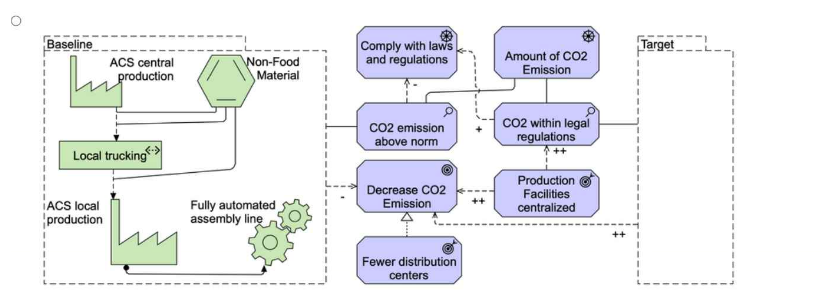
B.
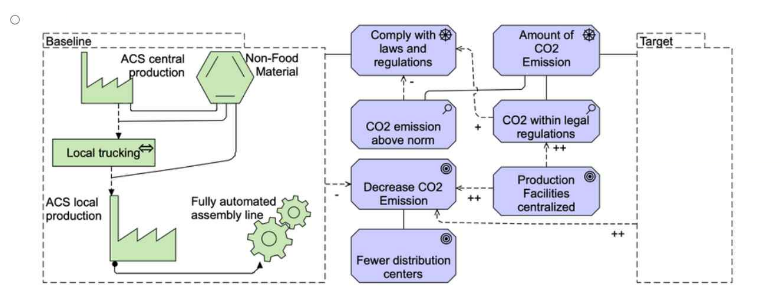
C.
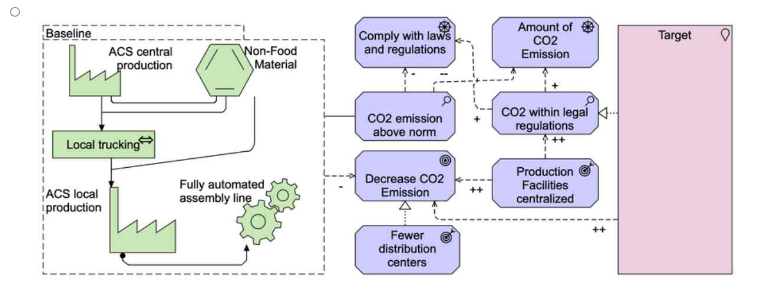
D.
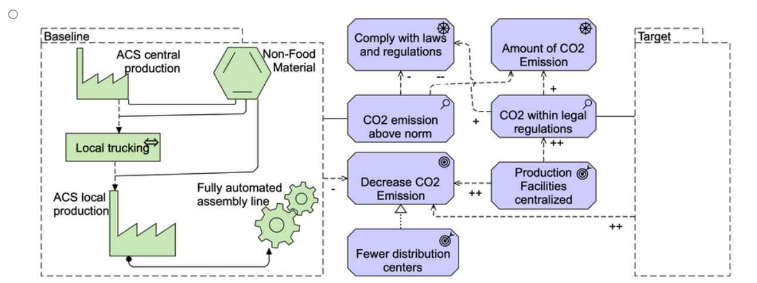
Answer : D
The correct answer is D, as it best describes the transition from the baseline to the target state, including the motivation for changes based on the scenario. Here's a detailed explanation of why D is the most accurate model:
Baseline and Target:
The Baseline state in all answers correctly depicts the current structure of ACS's operations, including the ACS Central Production, Local Trucking, ACS Local Production, and Fully Automated Assembly Line.
D captures the essential transition from this baseline state to the target state by illustrating how the organization is aiming to decrease CO2 emissions, as required by the new regulations, and how they intend to centralize production facilities.
Motivation for Changes (Decrease in CO2 Emissions):
The CEO's plan to reduce CO2 emissions is a critical driver for change. This is captured clearly in D, which shows the effects of Decreasing CO2 Emissions, Complying with Laws and Regulations, and Centralizing Production Facilities.
The Ministry of Social Welfare and Health's law mandating CO2 reductions is accurately reflected in D, showing compliance as part of the motivation.
D also depicts the motivation to centralize production facilities, which helps reduce CO2 emissions and aligns with the internal report suggesting that fewer distribution centers can meet ACS's needs effectively.
Business and Environmental Factors:
The scenario also points out that passenger numbers have decreased due to rising ticket prices, which reduces the demand for non-food materials from ACS. This factor is linked to the centralization effort, as reducing the need for distribution centers can reduce costs while still meeting business needs.
D reflects this by linking Fewer Distribution Centers and Centralized Production Facilities to both decreased emissions and operational efficiency.
Compliance with Laws and Regulations:
D shows a clear connection between compliance with CO2 Emission Laws and the Amount of CO2 Emissions generated by ACS, which is an essential driver of change in the scenario.
The need to ensure that emissions are within the legal limit is modeled effectively in D, reflecting the scenario's requirement to meet regulatory expectations by the end of the year.
Centralization of Production:
The scenario suggests that centralizing production is one way to reduce emissions and achieve operational efficiency. This is depicted clearly in D, where Production Facilities Centralized leads to both fewer distribution centers and a significant decrease in CO2 emissions.
D links the motivation for fewer distribution centers to environmental sustainability (CO2 reduction) as well as operational improvements.
Comprehensive ArchiMate 3 Compliance:
D aligns well with ArchiMate 3 standards. It models the Motivation Elements such as goals (e.g., Decrease CO2 Emissions), assessments (e.g., CO2 Emission Above Norm), and requirements (e.g., Comply with Laws and Regulations) accurately.
The relationships between these motivation elements are correctly depicted using ArchiMate connectors like influences and associations, ensuring that the transition from baseline to target is clear and fully compliant with ArchiMate 3 best practices.
Conclusion: Answer D provides the best representation of the proposed transition, focusing on the motivations for centralization and reduction of CO2 emissions. It accurately reflects the scenario's requirements, including legal compliance, environmental goals, and operational changes, all while following ArchiMate 3 modeling standards.
Please read this scenario prior to answering the question
The ArchiSurance senior management, board members, customers, and major stockholders have expressed long-standing concerns regarding the business continuity risks associated with relying on a single data center. Located in an area prone
to flooding, earthquakes, and occasional water leaks from the cafeteria above, the current data center has significant vulnerabilities.
To address these concerns and mitigate the risks, ArchiSurance has developed a comprehensive plan to relocate its existing data center to two separate ready-to-use data centers in different cities. As a major undertaking, the approval of the
Board of Directors is required to proceed with the project.
The primary objectives of the data center move are to reduce the risk of business interruptions, reduce both planned and unplanned downtime for critical applications, and provide reassurance to ArchiSurance stakeholders. Ensuring minimal
disruption during the transition is crucial. However, several constraints make the planned migration to the new data centers particularly challenging. Certain critical ArchiSurance applications cannot be offline for more than one hour, and any
planned downtime must be restricted to specific four-hour windows on weekends. Additionally, the migration cannot take place during quarterly or year-end closing periods to avoid disrupting critical processing operations.
ArchiSurance management has devised a multi-phase data center transformation program to facilitate a smooth transition. Each phase is critical for establishing stable and fully functional data center configurations throughout the transformation
process. The initial phase entails detailed scheduling and planning to develop a comprehensive transformation plan aligned with ArchiSurance's timing and scheduling requirements. During the second phase, ArchiSurance will procure the
necessary hardware and software for the new data centers, while also seeking refunds for the hardware and software in the current data center once it is decommissioned. The third phase involves setting up the new data centers and conducting
parallel testing of the new hardware and software alongside the existing production environment. The transition between the old and new data centers occurs in the fourth phase, followed by the fifth phase, which is the decommissioning of the old
data center. This involves returning the hardware and software to obtain the contracted refunds. Each phase, from the second to the fifth, is initiated once specific conditions outlined in the previous phase have been met.
Refer to the Scenario
The program manager overseeing the data center transformation has asked you to model an outline of the implementation plan which has three stable states defined. You should show the deliverables associated with each plateau in connection
with the physical elements. Additionally, you need to show how each phase contributes to achieving a stable state for the data center transformation.
Which of the following answers provides the best description?
A.

B.

C.

D.

Answer : A
This question focuses on modeling the implementation plan for the data center transformation at ArchiSurance. The goal is to represent how the different phases of the project contribute to achieving the three stable states, or plateaus, while illustrating the deliverables connected to these plateaus and the physical elements involved.
Key ArchiMate 3.2 Concepts Applied:
Plateaus: Plateaus represent intermediate stable states within an architecture transformation, showing the condition of the architecture at specific moments in time. In this scenario, the plateaus correspond to the stable data center configurations at different phases:
Plateau 1: Only the old data center is in use.
Plateau 2: Both the old and new data centers are in use simultaneously.
Plateau 3: Only the new data center is in use, and the old data center is fully decommissioned.
Physical Elements: These refer to the data centers, hardware, software, and networks that make up the infrastructure being migrated. These should be clearly depicted in connection with each phase of the transformation program.
Deliverables and Phases: Each phase of the transformation process includes specific deliverables, such as:
Procurement of new hardware and software.
Setting up and testing the new data centers.
Transitioning between the old and new data centers.
Dismantling the old data center and returning its hardware for refunds.
Work Packages and Dependencies: Work packages represent activities or tasks in ArchiMate and are connected to the plateaus. These must be modeled with proper sequencing, showing how each phase contributes to reaching the next stable state.
Why Option A is Correct:
Option A accurately represents the three plateaus (stable states) and clearly illustrates the deliverables (e.g., the new data center, tested hardware and software, and dismantled old data center) in relation to each phase of the transformation.
The connections between the physical elements (such as the centralized data center, distributed data center, and backup data center) are properly displayed and aligned with the described multi-phase process.
The phases are laid out logically, showing how each phase (e.g., procurement, testing, transition) leads to the next stable state (plateau), following the principles of a plateau and work package transformation in ArchiMate.
The flow of deliverables from one plateau to the next is consistent with the need for dependencies (e.g., the new data center cannot be fully active until the hardware and software have been tested in parallel).
Why Other Options Are Incorrect:
Option B and Option D do not show the relationships between the phases and the stable states as clearly as Option A. They lack some critical connections or do not accurately represent the progression between plateaus and the physical infrastructure.
Option C is closer but misses important sequencing in how the work packages (activities) and plateaus interact, leading to an incomplete representation of the transformation.
Conclusion:
Option A provides the most complete and accurate description based on ArchiMate 3.2 modeling principles. It correctly demonstrates how each phase of the data center transformation contributes to achieving the stable states (plateaus) and ensures that the physical elements, work packages, and deliverables are properly aligned.
Please read this scenario prior to answering the question
The ArchiSurance senior management, board members, customers, and major stockholders have expressed long-standing concerns regarding the business continuity risks associated with relying on a single data center. Located in an area prone to
flooding, earthquakes, and occasional water leaks from the cafeteria above, the current data center has significant vulnerabilities.
To address these concerns and mitigate the risks, ArchiSurance has developed a comprehensive plan to relocate its existing data center to two separate ready-to-use data centers in different cities. As a major undertaking, the approval of the Board of
Directors is required to proceed with the project.
The primary objectives of the data center move are to reduce the risk of business interruptions, reduce both planned and unplanned downtime for critical applications, and provide reassurance to ArchiSurance stakeholders. Ensuring minimal disruption
during the transition is crucial. However, several constraints make the planned migration to the new data centers particularly challenging. Certain critical ArchiSurance applications cannot be offline for more than one hour, and any planned downtime must
be restricted to specific four-hour windows on weekends. Additionally, the migration cannot take place during quarterly or year-end closing periods to avoid disrupting critical processing operations.
ArchiSurance management has devised a multi-phase data center transformation program to facilitate a smooth transition. Each phase is critical for establishing stable and fully functional data center configurations throughout the transformation process.
The initial phase entails detailed scheduling and planning to develop a comprehensive transformation plan aligned with ArchiSurance's timing and scheduling requirements. During the second phase, ArchiSurance will procure the necessary hardware and
software for the new data centers, while also seeking refunds for the hardware and software in the current data center once it is decommissioned. The third phase involves setting up the new data centers and conducting parallel testing of the new
hardware and software alongside the existing production environment. The transition between the old and new data centers occurs in the fourth phase, followed by the fifth phase, which is the decommissioning of the old data center. This involves
returning the hardware and software to obtain the contracted refunds. Each phase, from the second to the fifth, is initiated once specific conditions outlined in the previous phase have been met.
Refer to the Scenario
The IT department's leader has assigned you the task of creating a model to explain the rationale behind Archisurance's decision to transform its data center infrastructure. The model should show the concerns and motivations of the stakeholders
involved. Additionally, it should outline the specific goals to be achieved through the data center transformation program, the associated deliverables, and the limitations that must be considered throughout the program's implementation.
Which of the following answers provides the best explanation?
A.

B.
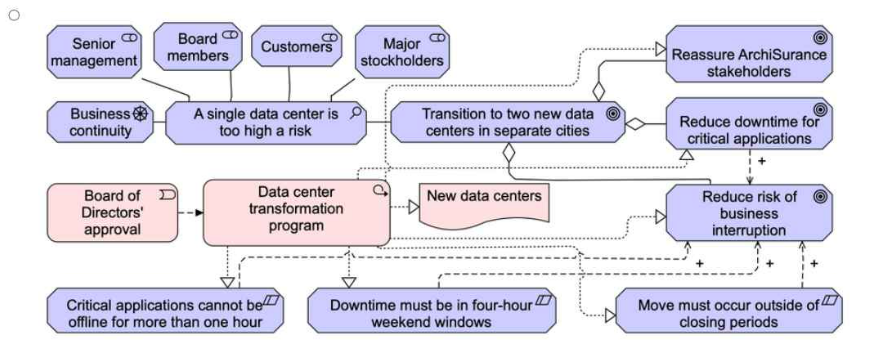
C.
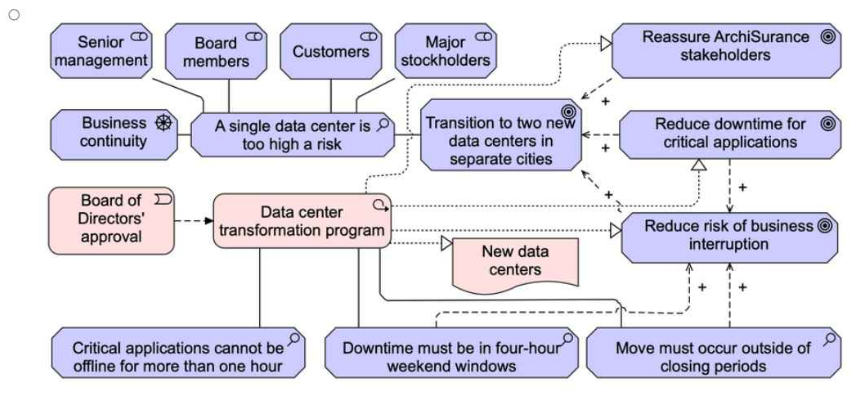
D.
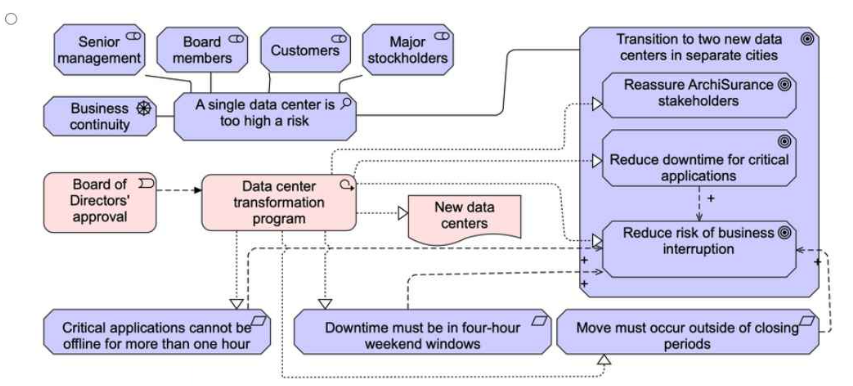
Answer : C
We need to identify the most accurate and complete model that explains:
Stakeholder Concerns & Motivations -- Including senior management, board members, customers, and stockholders.
Objectives & Goals -- Reducing business risks, minimizing downtime, and reassuring stakeholders.
Deliverables -- The transition to two new data centers and data center transformation program.
Constraints & Requirements -- Planned downtime limits, critical application uptime requirements, and scheduling constraints.
Why C is the Best Choice:
Includes all stakeholder concerns -- Clearly represents business continuity risks and the rationale for transitioning to two new data centers. Clearly defines the objectives -- Reducing downtime and risk of business interruption. Shows key constraints --
Critical applications cannot be offline for more than one hour.
Downtime must be in four-hour weekend windows.
The migration must avoid closing periods. Links deliverables to objectives -- The data center transformation program and new data centers are clearly positioned as solutions. Represents dependencies correctly -- Showing how each motivation leads to a goal, which leads to a deliverable.
Why Not A, B, or D?
A: Does not establish a strong link between the concerns and the solution clearly enough.
B: The structure does not align well with the scenario requirements, and some constraints and dependencies are missing.
D: Overcomplicates some relationships and does not emphasize stakeholder concerns effectively.
Please read this scenario prior to answering the question
The ArchiSurance Mobile consumer solution is used for selling and renewing insurance products, providing customer service, enabling accurate and convenient home recordkeeping, and capturing and processing claims. The solution consists of
three applications. The Consultant application lets customers review their existing coverage, and update it based on common life events, such as getting a new car, moving into a new home, or having a family member move in or out. If necessary,
they can speak or chat with a customer service representative. The Home Manager application helps customers photograph and catalogue their valuable possessions in order to support the filing of accurate claims in case of loss or damage. The
Claim Manager application enables customers to quickly file a claim for loss or damage to an insured auto, home or possession. It enables customers to describe the incident by referencing information captured with the Consultant and the Home
Manager applications. In addition, it allows the customer to add photographs, audio, video and text to support a claim, submit the claim, and monitor its progress.
The ArchiSurance Mobile applications rely on a number of application services hosted by ArchiSurance. The first is an Auto Identification and Description (AID) service that the Consultant application uses to validate and complete auto information
entered by customers. The second service, Home Identification and Description (HID) performs the same function for home information, and is used by the Home Manager application. The Consultant application also uses the Virtual Agent
service to guide customers as they select coverage options, the Payment Processor service to arrange premium payments, and the Coverage Activator service to generate policies and put them in force.
ArchiSurance Mobile also relies on a number of technology services. The Home Manager application uses a Multimedia Repository service to store and retrieve information about insured homes. The Claim Manager application also uses this
service for claim information entered by customers. All three ArchiSurance Mobile applications use a Personal Security service to register and authenticate customers, and to manage their profiles.
Each application service is realized by an application component with the same name. Each technology service is realized by a system software environment, having the same name. ArchiSurance hosts both the application components and
system software environments in a virtualized server pool within its data center. Each service has its own virtual server. Each virtual server is connected to a data center network (DCN) which in turn connects to a commercial wide area network
(WAN).
Refer to the Scenario
You have been asked to show the applications that make up the ArchiSurance Mobile solution and the technology that supports these applications.
Which of the following answers provides the best description? Note that it is not necessary to model the networks.
A.
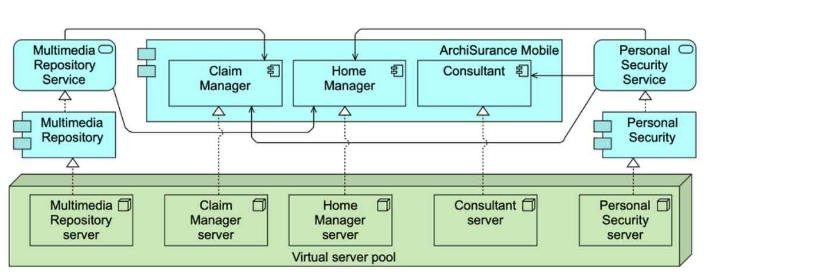
B.
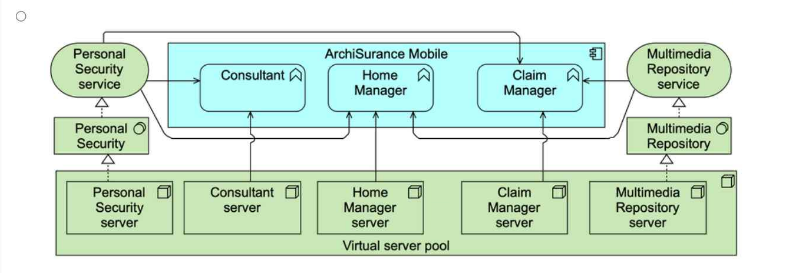
C.
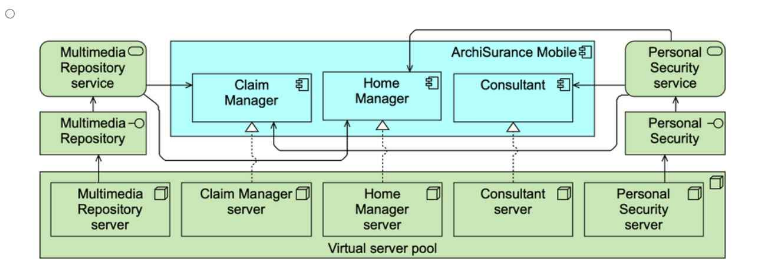
D.
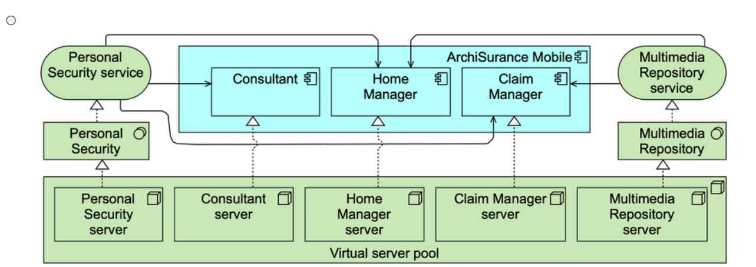
Answer : C
In this scenario, the focus is on modeling the ArchiSurance Mobile solution, showing the applications that make up this solution and the technology infrastructure that supports them. This includes applications, application services, and the system software environments (technology services) upon which the applications rely.
Key ArchiMate 3.2 Concepts Applied:
Application Components and Services:
Consultant Application: This allows customers to review, update coverage, and speak with customer service representatives. It uses the following application services:
Auto Identification and Description (AID) for validating auto information.
Virtual Agent for helping customers select options.
Payment Processor to arrange payments.
Coverage Activator to generate and activate policies.
Home Manager Application: This allows customers to catalogue possessions and use the Home Identification and Description (HID) service to validate home information.
Claim Manager Application: Enables filing of claims, referencing data from the Consultant and Home Manager applications and storing information (such as photos, videos) via the Multimedia Repository.
Technology Services:
Personal Security Service: Used for customer registration, authentication, and profile management across all three applications.
Multimedia Repository Service: Used to store and retrieve information related to home possessions and claim details, supporting both the Home Manager and Claim Manager applications.
Technology Infrastructure:
Each application component (Consultant, Home Manager, Claim Manager) is hosted on its own virtual server within a virtualized server pool.
Each technology service is realized by a corresponding system software environment (e.g., Multimedia Repository, Personal Security), each with its own virtual server.
The infrastructure is hosted in a data center, but the focus here is on the services rather than the network connections.
Why Option C is Correct:
Option C accurately represents the key applications (Consultant, Home Manager, Claim Manager) in connection with the appropriate technology services and their respective virtual servers.
The model shows the relationships between the applications and their dependencies on Personal Security and Multimedia Repository, aligning with the description provided.
The virtual server pool is depicted clearly, showing how the applications and services are realized within this infrastructure.
The relationships between applications and application services (AID, HID, Virtual Agent, Payment Processor, Coverage Activator) are not modeled in full detail here, but they are implicitly understood through the applications.
Why Other Options Are Incorrect:
Option A and Option D both incorrectly depict some relationships between the applications and their supporting technology services or servers, or miss certain dependencies.
Option B does not provide as clear a depiction of the virtualized infrastructure and how the applications relate to the Multimedia Repository and Personal Security services.
Conclusion:
Option C provides the most accurate and complete description of the ArchiSurance Mobile solution and the supporting technology, as required by the scenario. It correctly illustrates the relationships between the applications, the virtual servers, and the supporting technology services according to ArchiMate 3.2 principles.